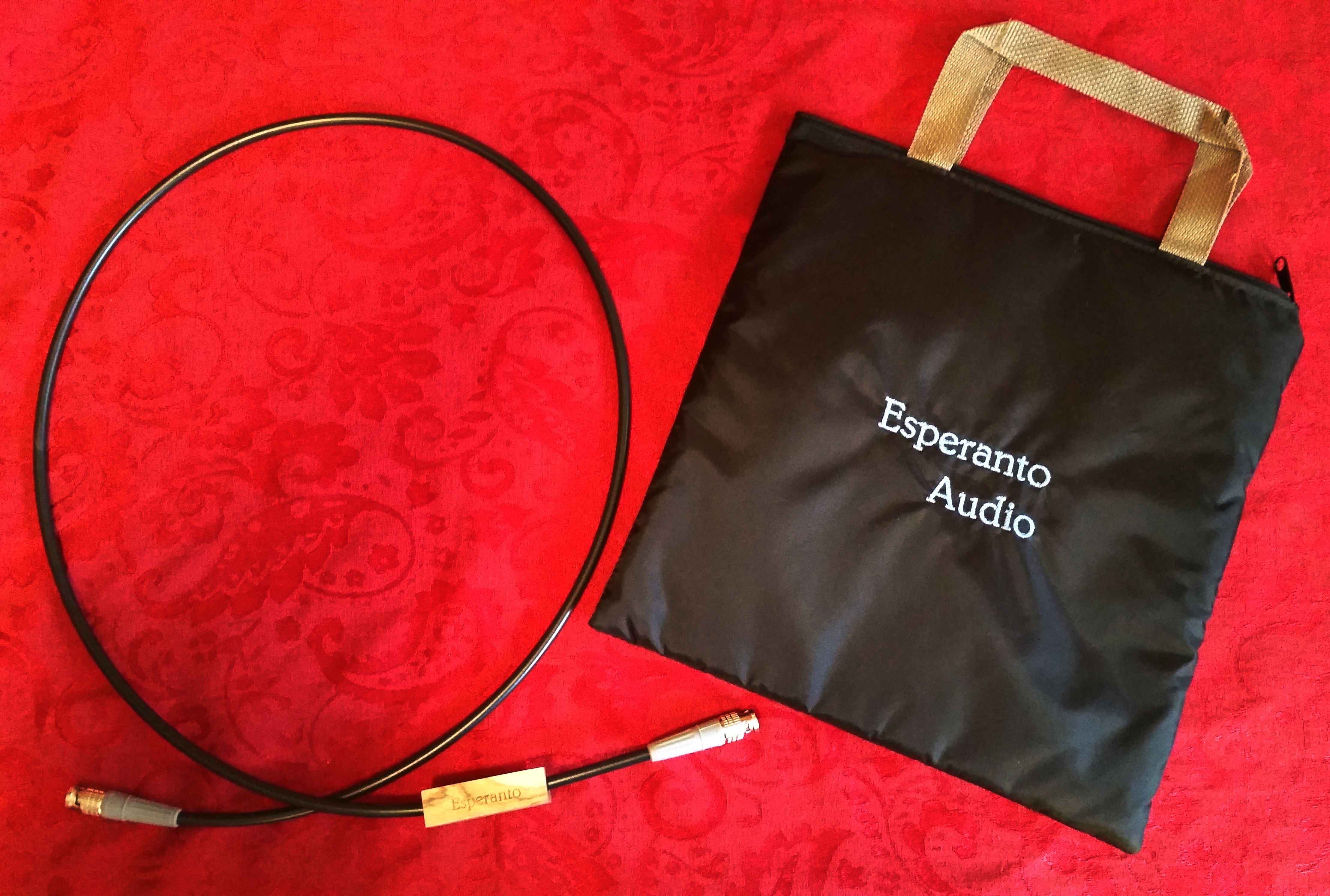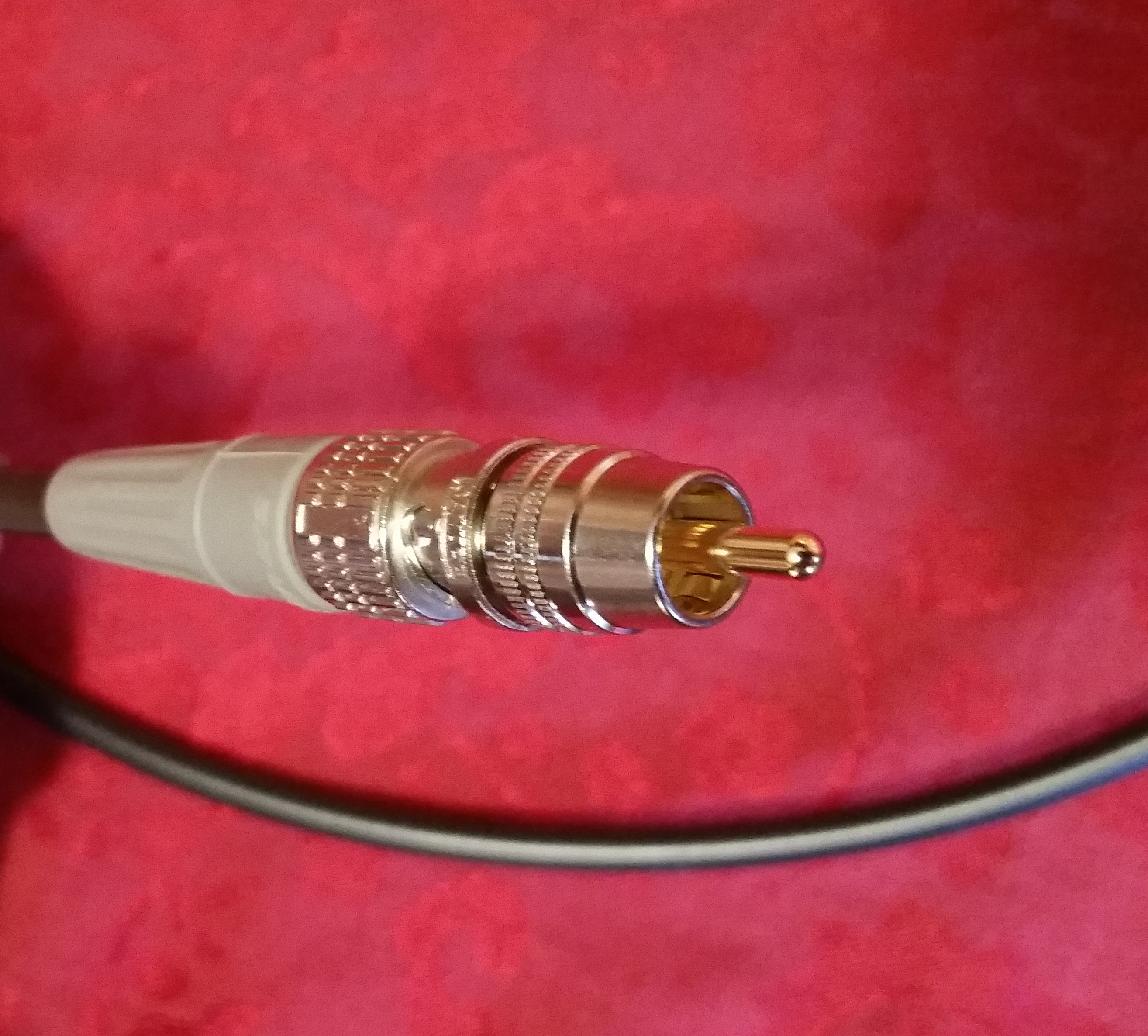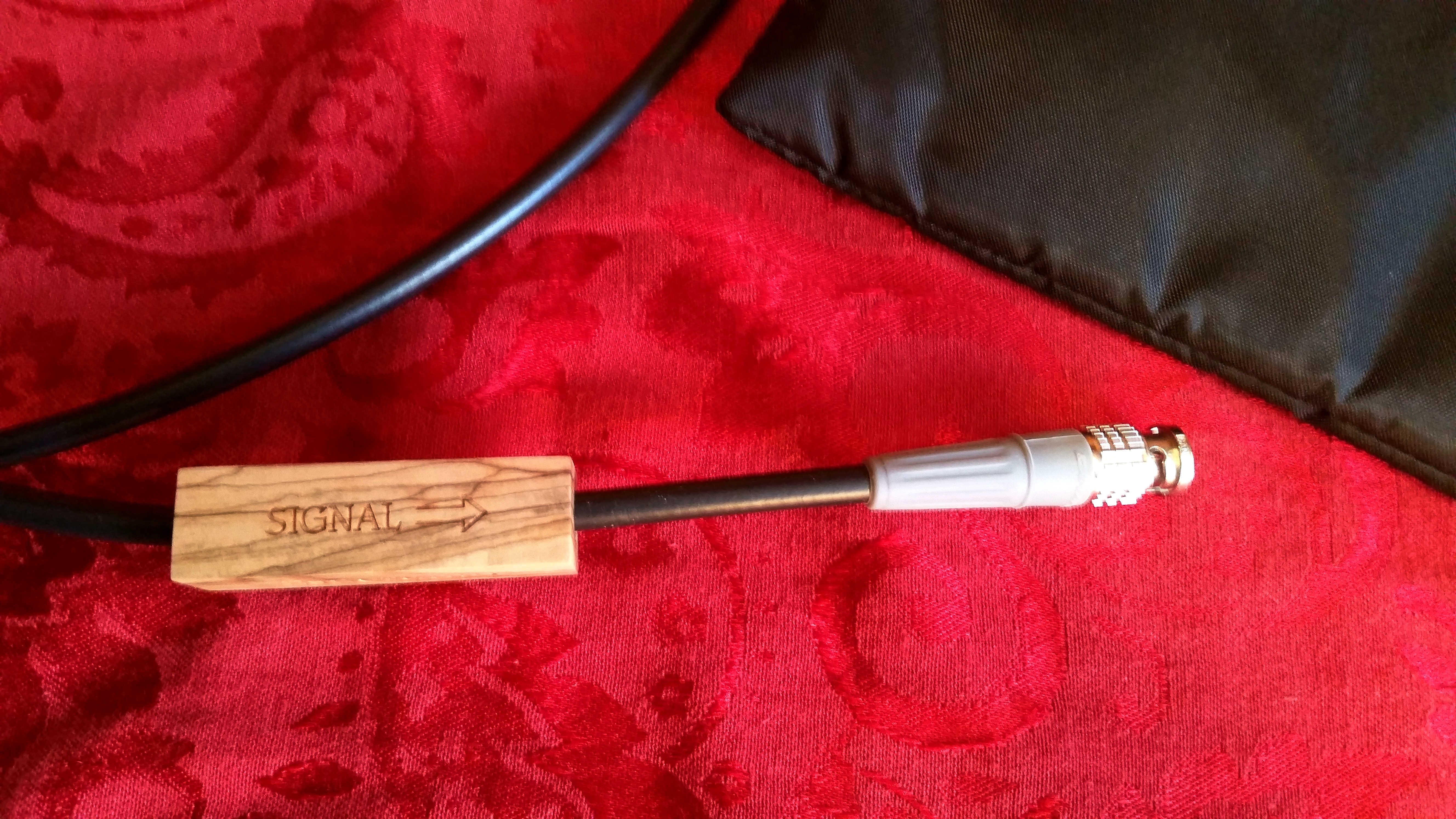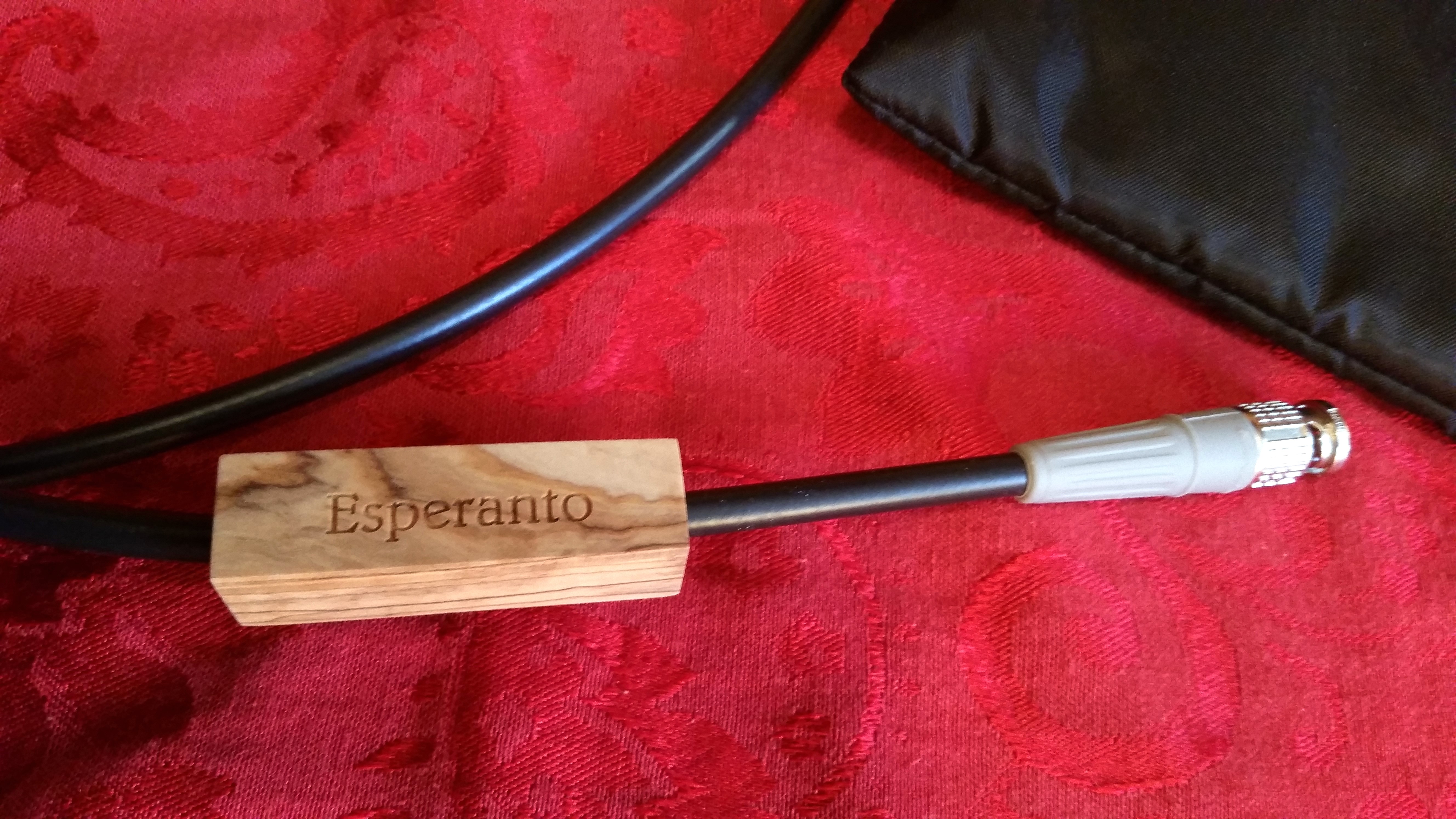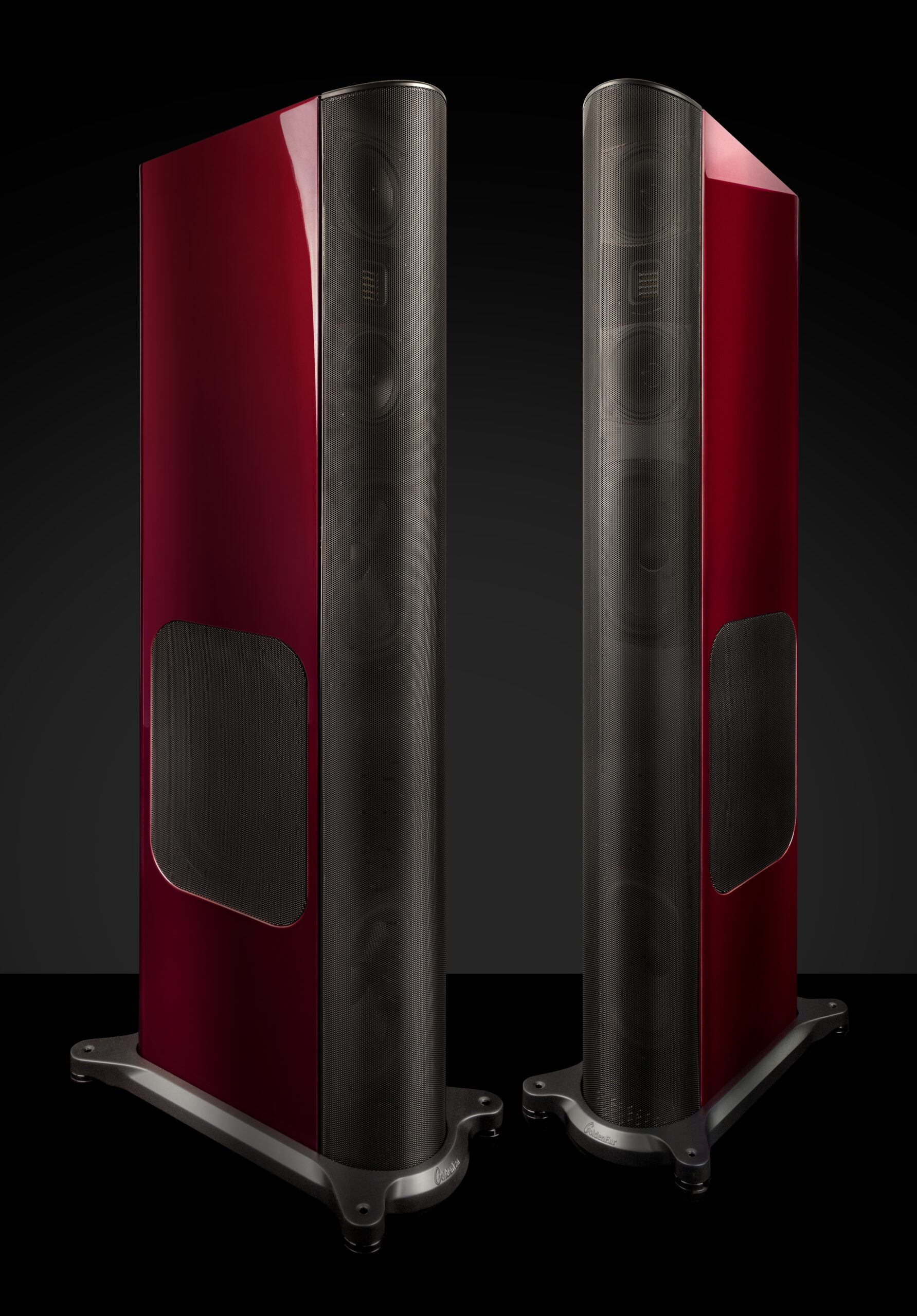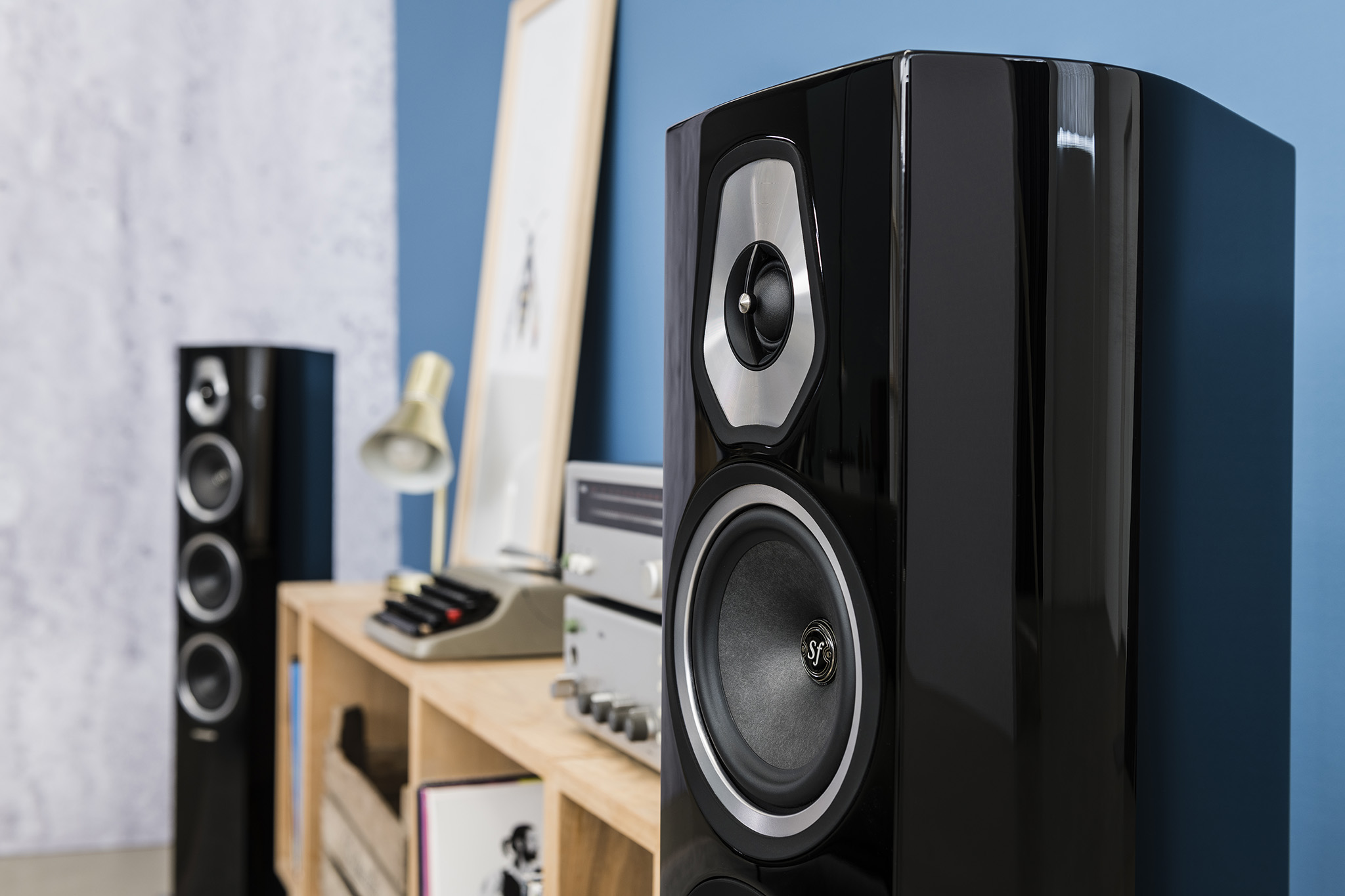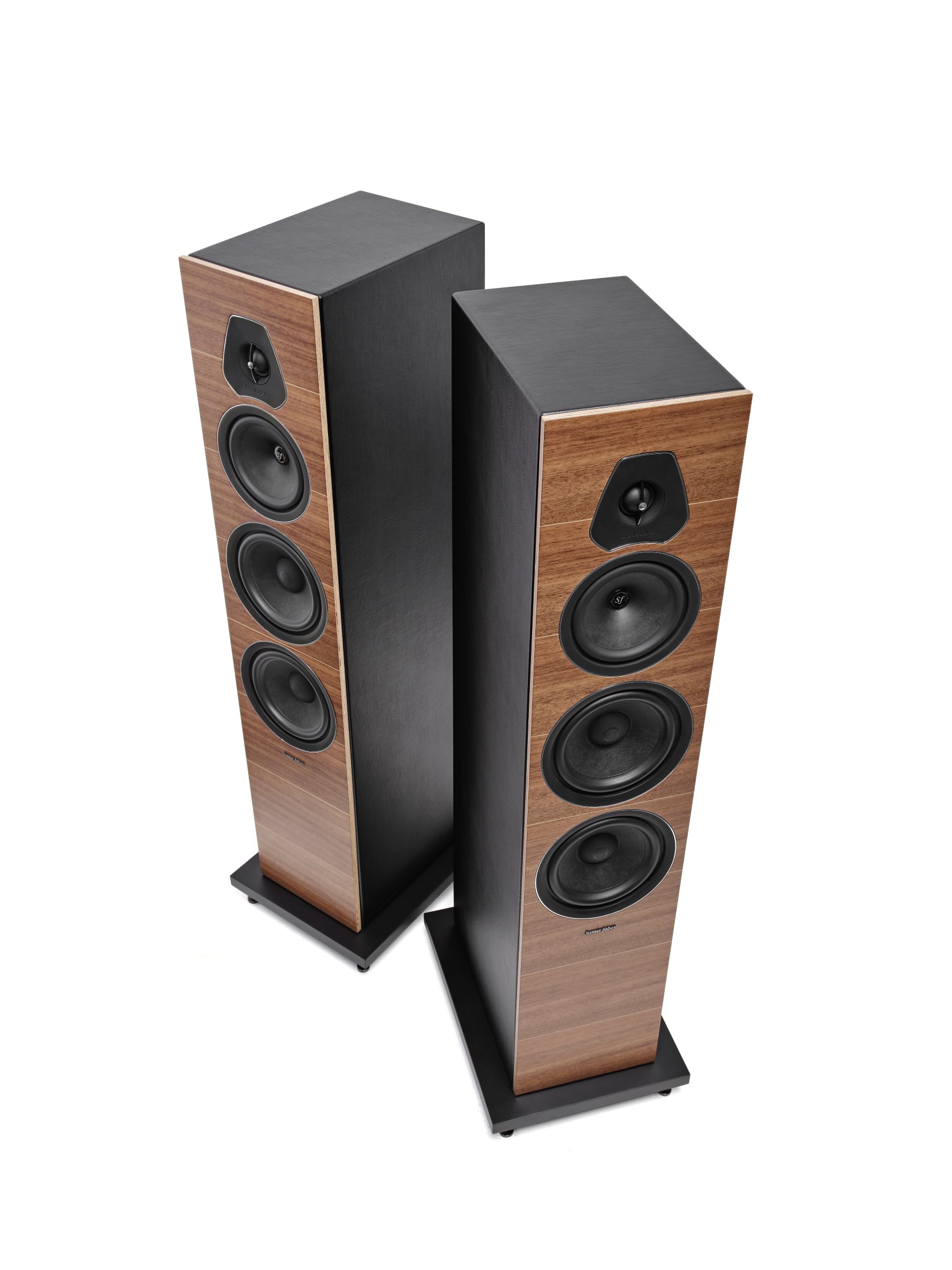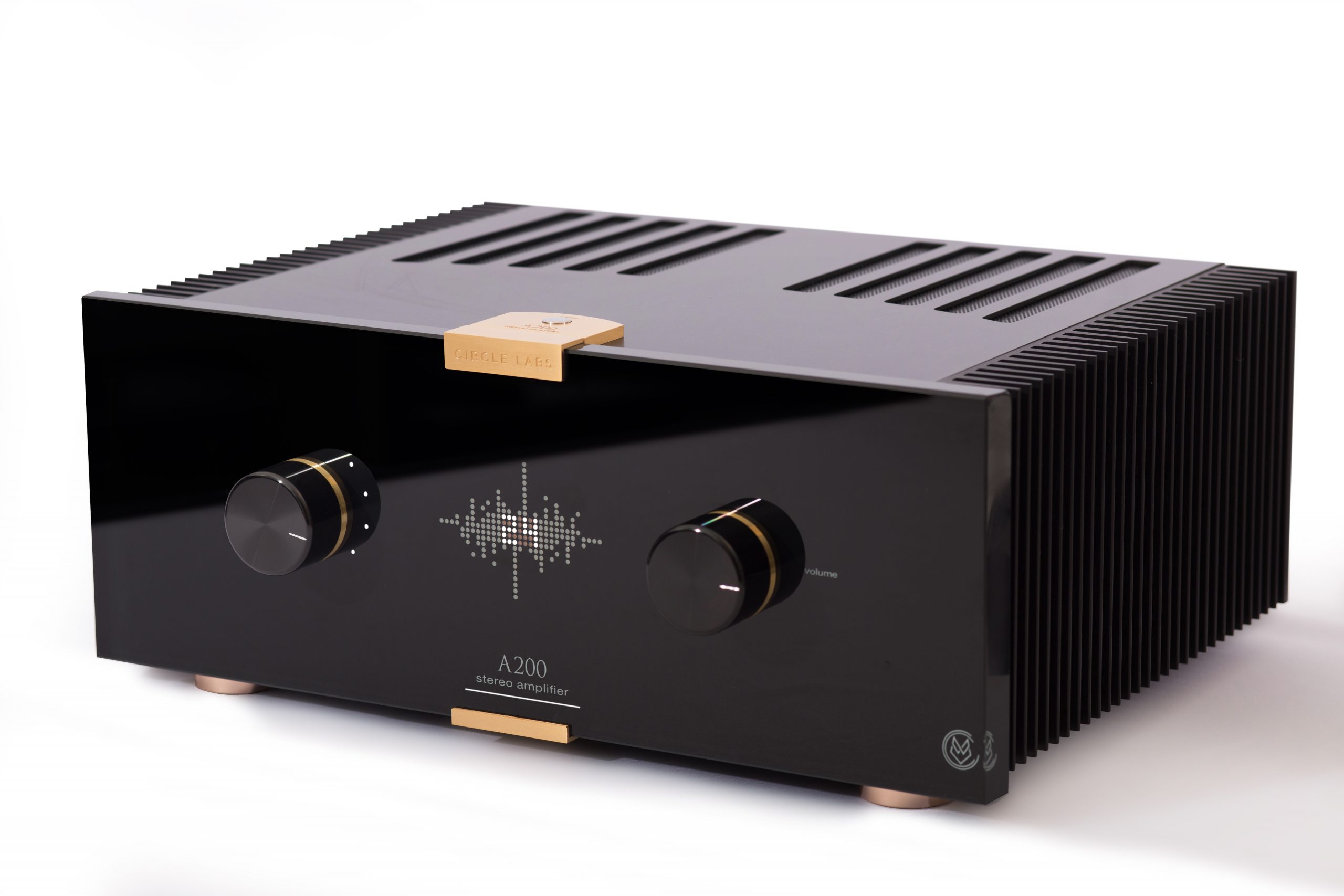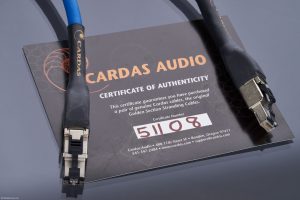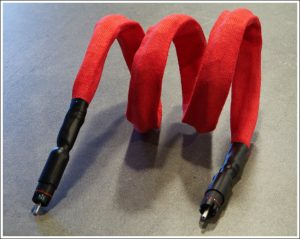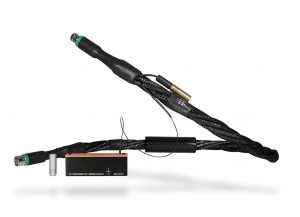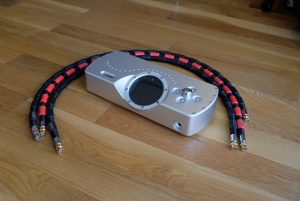Michael Zisserson's review of the Esperanto Audio Black S/PDIF Cable is published with a disclosure. Michael has done some professional work for John Marks in the realm of speaker design, and this should be disclosed so that our readers are aware of this fact. I do not see this to be a conflict of interest, first on the ethical principle that full disclosure equals no conflict of interest, and second upon my own listening to the Esperanto cables, which indicates that they are, indeed, quite fine.
With this caveat in place, readers may proceed with the perusal of Michael's review...or not. Caveat lector!
Dr. David W. Robinson, Ye Olde Editor
Everything we experience in life is a sum of our prior experience's parts. The same is true when a life-long industry professional decides to take his accumulated musical knowledge and begin a solo journey in service of the music. The latest result is the Black digital cable from John Marks' company, Esperanto Audio, and it may very well be the digital upgrade many have been looking for.
The Complex Formula
One thing is for certain: No reader of this review will have to employ any math that is not of their own choosing. The formula being referred to here is the one which consists of the science, and application of said science to create the Esperanto Audio "Black." It begins with the company.
Esperanto Audio is a small, artisan-style company founded by former Stereophile (and TAS) columnist John Marks. Some readers may have recently perused some of John's recent work as republished here at Positive Feedback from his personal music and audio blog The Tannhäuser Gate (www.thetannhausergate.com). John brings to Esperanto Audio his experiences as a record producer and audio engineer, music historian and writer, audiophile, and even his time spent (long ago) as a trial lawyer.
However the most important contributing elements that John brings to Esperanto Audio are his deep obsession with engineering details, and uncontrollable perfectionism. Evidence of these last elements come in the form of a blog post centered around a small, but interesting bit of his study regarding the challenges and engineering of the original transatlantic telegraph cable HERE.
Ultimately, from his obsessive study of digital signal transmission and digital electronics, John launched Esperanto Audio with the USD $600 Blue S/PDIF (Sony Philips Digital Interface) digital audio cable, which focuses on attention to detail in the construction, the proportions within the cable, and was set to reduce errors in the embedded clock signal of the bitstream caused by internal reflections due to impedance mismatches. The Esperanto Black cable is an upgraded version of the Blue cable, which takes the same set of design ideas and implements a more over-the-top execution.
The attention to fine detail concludes in a beautiful, well-packaged product to assure that no hard bends can affect the cable's inner proportions. John has even gone through the effort to source the packaging through Porta-Brace in Vermont, most well-known for their professional camera cases and covers. One of my personal favorite details is a drool-worthy block of olive wood from the Holy Land for the Black that is laser engraved with the signal direction, serial number, and company name. John hand-sands, then treats the block with orange oil and beeswax which gives a finish comparable to fine furniture. This is a slightly different approach to the usual silk-screened arrows lazily slapped on a cable's jacket or connector. When asked why so much effort goes into the direction marker which is typically silk-screened onto most cables, John's response is a hearty, old-fashioned, "Anything worth doing is worth doing well!".
Dig deeper into the functioning of the Black S/PDIF cable and the attention to detail in what cannot be seen is there as well. The Black utilizes a large conductor, which has 56% more metal in its core than its smaller-sibling Blue cable. The Black also has more sophisticated dielectric material, and a higher quality shield. No solder is found in the Black cable; rather the connections are made via high quality machine crimping where the pressures involved fuse the metal parts together. This process of high-pressure crimping creates a joint that is stronger than a solder joint, is more reliable, and simplifies the electrical connection by having less complexity within the metals which can generate noise.
The Black is only available with BNC terminations. This is due to the larger cross-section of the Black cable's center conductor. Quite literally searching the world, John has found a supplier out of Japan who provides a high quality BNC-to-RCA adaptor which is provided free of charge if required.
One exponential which raises the Black above any cable I have experienced is the provided analog burn-in tone developed by John that utilizes PCM clock signal sub-fundamentals and harmonics spanning 15 octaves of signal bandwidth. Ignoring the instructions included regarding the proper utilization of this disc will guarantee a moment not unlike that of an apocalyptic movie as you stand before the ruins of both your loudspeakers and amplifier in glaring shock. That is because the burn in disc contains enormous square-wave, sub-harmonic energy that is the enemy of loudspeakers, and super-harmonic energy that can make amplifiers surge into oscillation.
John created this sound file at the DXD resolution of 352.8kHz, in order to include square waves up to 88.2kHz. In order to keep the file size manageable, the tone lasts about 15 minutes, but, seeing as it can only be played via computer audio, playing the tone on repeat by use of a program such as Audirvana is the recommended use. The Burn-in file is provided via drop-box download or USB key.
Executing the burn-in is fairly straight-forward. Since the signal is analog, it is as simple as replacing one of the DAC output channels to the pre-amplifier or amplifier with the Black during Burn in. If it is an absolute must that the Mandelbrotian Fractal of square waves is heard, John cautions to peak at little more than a whisper.
Following the instructions will ultimately yield a favorable result in the form of a fully burned-in cable in a matter of hours, verses hundreds of hours of normal program. This is a great showing of why the formula for Esperanto Audio is a successful one: Attention to detail and focus on quality through every step of the small-batch manufacturing.
No pretending
There will be no debates, no euphoric descriptions, and no philosophical discussion regarding the influence of cables in the audio chain while listening. Every cable is a complex amalgam of capacitive, inductive, and resistive properties; also, induced mechanical resonances which is a particular bugbear of John's. Every mechanical and chemical (solder-type) connection causes reflective effects in the signal. Every proportion in the cable effects signal flow. Every cable designer who has studied the effect of these complexities works toward optimizing all of these effects.
In a similar vein, the book Loudspeakers for Music Recording and Reproduction (2013, P. Newell, K. Holland) devotes an entire chapter to the result of marrying a loudspeaker to an amplifier via various cables. The results are not surprising in that the well-cited, well-documented, and measured effects across the bandwidth of the audio spectrum are very real. Once the wheat is separated from the chaff, Newell and Holland go on to discuss what can be done to minimize any derogatory cable effects from amplifier to loudspeaker that may be audible through rigorous application of the science.
Yet we are not talking a high power analog signal as a loudspeaker receives from an amplifier, and we are not talking about the recipient of the signal being the human ear. Signal preservation and the accuracy of the delivery are even more important when digital signals are sent from component to component. Timing errors, bit errors, electronic noise both internally generated and externally received, all add up to distortion of the signal. This distortion occurs primarily in the form of jitter that arrives at the end of the audio chain in many unpleasant ways. Ultimately, there is an entire field of study as to these effects and to correlate thin-sliced bits during listening will not do much good for anyone.
The remainder of this evaluation and any comparisons will be navigated with this approach, and the aforementioned understandings, as the guiding compass.
A Couple for Comparison
After listening to a well broken in Black cable handshaking and data-transmitting between my Jaton Opretta CD1000B and Bricasti Design M1 DAC, it seemed better to have a couple of different models of cables to compare with before noting what truly makes the Black exceptional.
First is a mini-mite of sorts available through Guitar Center and as affordable as it gets. It is made by Hosa, a California based professional audio giant who found their way to the mainstream in 1984 by filling the market need at the time for adapters and cables. About $10 and a hand-full of change adorned with pocket lint will get you three or more feet of a double-shielded 75ohm coax terminated with acceptable connectors. Heck, they even have a little spring spiraling down from the connector's base about one-half inch to relieve strain on the wire. Simply put: This S/PDIF graced my system for some time because it was difficult to justify the thought of spending twenty times (or greater) as much to get significantly better performance elsewhere. The world of better performance indeed existed however, and it happened upon me somewhat by accident.
During a demonstration of the new (at the time) Bricasti M28 amplifiers, John Marks walked into the room with an unassuming S/PDIF cable and requested it be put in the system, if nothing else but "for some giggles". No one knew, but this length of cable happened to be the prototype for the Esperanto Blue cable. It is sixty-times the price of the Hosa; however, it is the first cable I have heard from any manufacturer that significantly improved the sound quality, in every dimension, over the Hosa—to the point where I was compelled to take a fist-full of cash and beg a company to take it.
In the M28 demonstration system, the Blue replaced a similarly priced (a few years back) cable no longer available from the renowned manufacturer Nordost. (Unfortunately, I have not had the privilege of hearing Nordost's recent offerings, knowing what a difference a handful of years can make in product advancement.) Alas, the Esperanto Blue was a value to my ears, and that is how it found a new home in my system. The Blue will be used as the second cable during evaluation.
Two Tracks
Luckily the smallest state in the union, Rhode Island, has more than crooked politicians and coffee milk. There are many who form a nebulous audio community, and what better way to learn about music than through fellow music lovers? The two albums that the selected tracks come from made it to my ears through a member of this unofficial group named Jeff. Each of the albums that the tracks are taken from is worth a good, critical listen to completion in their own right. Each track will highlight the differences between the cables, and why it is important to consider the quality of the pipelines feeding a system.
Jack Johnson is a singer-songwriter, born and raised in Oahu, Hawaii. Jack had a short-lived stint in the professional surfing world, which ended in a gnarly crash. Jack landed on his feet at the University of California where he graduated with a B.A. in Film Studies. In college, his love for music grew and he decided to take his musical talent, which he has been nurturing since eight years of age, to new heights. His third album, In Between Dreams (Brushfire Records B0004149-02) is a more mature take on his bubbly folk-rock, acoustic style, which is well recorded for a "pop" album that peaked at number two on the US Billboard 200.
"No Other Way" is the fifth melodic track infused with influence from greats like Bob Dylan, Bob Marley, Sublime, and even his favorite guitarist of all-time, Jimi Hendrix. It was no surprise that the Hosa did a fine job setting a baseline for the Blue and "Black." From the first flam-like plucks of Jack's guitar there is a sincere amount of integrity with a very neutral presentation. The transition to some sliding work is satisfying.
In a funky, reggae feel, the drums and bass kick in finishing the intro to "No Other way" with a nice light off-beat emphasis which belies the dissonance on some of the chord work. Jack's twisted and metaphorical lyrics follow this feeling as he talks of worry for another, not having all of the answers, and begs for peace in love. It is a good showing that the Hosa was able to bring this to light; however, the Blue had quite a bit more to offer.
The Blue brought not just the song and its meaning, but the world the song was staged in. There was more life-like character to the guitars, which created an atmosphere like sitting on a beach with a lazy fire of driftwood with some friends playing music. The attack as each string left the pick was orders of magnitude better defined in presence and shape. The tone of the acoustic guitar was presented with the instrument body, which was missed on the Hosa, and the start/stop of the drums walked with the song, not separate from, but in unity with both the guitars and bass.
Most importantly, Jack's breathy and somewhat short-throat voice had a texture that simply was not there with the Hosa. The background was black as pitch, and during the short chorus this characteristic of the Blue allowed the contrast for Jack and group to take you on a journey with them. This is a 44.1/16-bit PCM recording, so this is where it seems it should end sonically, but it does not.
The Esperanto Black was not just more in the sense of a Blue-but-better, rather it was as significant of a jump from the Blue as the Blue was from the Hosa. After switching back and forth several times trying not to play tricks on myself, I concluded that the "Black's" apparent addition to the inner detail and overall resolution is due to its ability to handle the data and embedded clock with less error. This seemed to be confirmed when listening to sheer contrast within the music as well.
There is nothing more frustrating than excitedly pressing the "Play" button and hearing that first moment of what appears to be greater detail, only to be let down that it is just a tonal artifact or worse, distortion that sounds great for a few moments, only to leave a listener fatigued in the long-term. As I proceeded through "No Other Way" I came to the conclusion that the Esperanto Black is the opposite of that effect, in that the resolution was true to the instruments themselves. Again, not more information, but information where it should be, when it should be ultimately allowing for a sense of enhanced realism.
The cymbals had body, and the bell-to-rim sonic quality was evident as it was when I would sit behind my old Pearl kit and jam with friends as a teenager. The bass, which is recorded primarily with the fundamental of the notes emphasized, took in its own distinct timbre and felt unquestionably like a bass guitar. The guitars and Jack's vocals were now not simply parts of the music, rather storytellers being presented with such an integrity I gave up trying to hear the "Better" and just enjoyed the song.
In 1995 the Jazz singer Cassandra Wilson released her album New Moon Daughter (Blue Note B000005H0D). After hearing the track "Harvest Moon," which was originally written by Neil Young, on a Blue Note compilation called Jazz Chillout (Blue Note 37971), it became clear that Cassandra Wilson needed to become part of my music collection.
Time has a way of testing all things, and aside from Jazz Chillout that was received as a gift, I never acquired any of Cassandra Wilson's repertoire. Only the first few notes were out of the loudspeakers, and it quickly became apparent that her work on Blue Moon Daughter is not just another jazz act, but was rather a beautifully-orchestrated, incredibly deep journey that is ultimately enhanced by its hypnotizing fidelity.
My initial impressions, as above, were realized through the Hosa. The Esperanto Blue made quick work of pushing the Hosa to little more than a distant afterthought. "Harvest Moon" contains a few eclectic instruments, percussion, and even the feel of a vacuum-still evening by a lake as the silence is broken by the gentile chirps of tree-frogs; all of which created the perfect back-drop for Cassandra's haunting, soft, and mature vocals. The bow across the upright bass fades in with a gentle touch and the bass is true to the instrument. The harmonic plucks which add the atmosphere to this rendition spark out of the dark with a realistically hard "pop" leading the note as fireflies would puncture the blanketing dusk on a warm, fall evening. Finally, with no anchoring rhythm, the guitar proceeds with delicate triplets after Cassandra convincingly sings of dancing and being in love under the harvest moon, rhythmically taking the song through the mystical picture already painted.
Still, despite how much of the music was portrayed by the Esperanto Blue, the Black was a lofty step above. It seems the primary characteristic (or lack thereof depending on how one would define it) of the Black that would strike me each time I would switch the cables around is the complete lack of apparent noise. Yet the Blue provides this too, so what is the essential difference which took me to the edge of frustration?
The answer seems to lie in the ability of the Black to provide a much higher degree of control over finer steps of contrast, dynamic range, and timbre. These characteristics amply brought "Harvest Moon" to life.
The number is in the low single-digits for how many times I have heard an entire system seem to fade away leaving only the music, yet the Black provided this feeling for me on this track. It was the technical correctness of the Black in its ability to pass all of the digital information, distortion free, with little loss, which did it for me. All that appeared to be left was simply the music.
A Reflective End
Being left with only the music is a very important audio aspect for me. For years the audiophile hobby for me was not unlike being on a hedonic treadmill. I was always looking for the next great piece, or big improvement, only to fool myself into thinking different was better. Luckily, I learned a hard lesson when I was engaged by a system that was not perfect at all, but it stood on its own and simply presented the music in a way that made me realize I did not care that the equipment was not some state-of-the-art masterpiece. This system consisted of painstaking detail from source, to cables, to loudspeakers, to room. It led to my personal realization that the whole could be greater than the sum of its parts.
Too many smart folks change loudspeakers when their source is the root-cause of their audio misery. Too many invest too heavily in a single area of their system and take little thought as to what real synergy can provide. This means, however, to achieve a wonderfully musical system every piece needs to be considered, even the signal cables.
The Esperanto Audio Black S/PDIF cable has found popularity in very sophisticated digital audio systems, such as being used in a dCS digital playback system with external word clocks. This means multiple Black cables are utilized to work with the ultra-precise, multiple chassis DAC system to assure perfect timing in all digital matters. This is a great example of a system being greater than the sum of its parts—in this case, with the Black being one of those parts.
As professionals, hobbyists, and music lovers we should all bear system synergy in mind. It is my conclusion that the Esperanto Black would be a valuable asset to many audio systems. Bearing in mind that we all have limits, I will likely pout for about a week's time before returning to my regularly scheduled listening through the Esperanto Blue, after returning the Black, simply because my piggy-bank is full of pennies, not nickels. Such is life.
The Esperanto Audio Black S/PDIF cable may very well be the PCM digital playback upgrade many have been looking for when they enjoy their systems, but are looking for a keystone to lock it all together. I am left with the conclusion that I know of no other way of achieving such fidelity as the Black did in my system.
The Black is definitely a running start for John Marks and Esperanto Audio.




